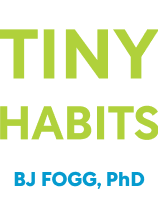

This article is an excerpt from the Shortform book guide to "Tiny Habits" by BJ Fogg. Shortform has the world's best summaries and analyses of books you should be reading.
Like this article? Sign up for a free trial here .
What are the seven steps to achieving goals from Tiny Habits? How can you turn a vague aspiration into a lasting habit?
According to BJ Fogg, there are seven steps to achieving goals. The steps are: pinpoint your outcome, brainstorm behavioral solutions, identify Golden Behaviors, find the tiny version, choose your prompt, celebrate, and refine.
Continue below for descriptions on how to carry out each of the seven steps for achieving your goals.
Steps to Achieving Goals
The Behavior Design process is the method we use to convert the Fogg Behavior Model into a new habit. It consists of seven steps to achieving goals, which we move through one by one to convert a vague aspiration into a lasting habit.
1. Pinpoint your exact aspiration or outcome. Get very clear on what exactly you want to achieve. The clearer your aspiration is, the more likely your new habit is to succeed.
For example, let’s say your aspiration is to be less tired during the day. But when you really think about the root of the problem, you might realize that a better aspiration is “Get better sleep.” You use this as the starting point for your design.
2. Brainstorm possible behavioral solutions. Write your aspiration in the middle of a page or whiteboard and put a circle around it. How many different specific behaviors can you come up with that might help you achieve this? Be wacky and creative as well as logical and realistic, and aim to write down at least 20 different behaviors. When you’re finished brainstorming, you’ll have a diverse Swarm of Behaviors (“Swarm of Bs”) that you can use in the next step.
For example, let’s continue with the aspiration “Get better sleep.” You might come up with the following behaviors: “Buy a blackout curtain,” “Try a white noise machine,” “Move to somewhere quieter,” “Try aromatherapy,” “Stop napping during the day,” and so on. When you have your initial set of behaviors, look over them and make sure they’re as specific as possible. For example, you could change “Try aromatherapy” to “Take a hot lavender-scented bath.”
3. Identify the Golden Behaviors. To find your Golden Behaviors, you engage in a process called Focus Mapping. To Focus Map, write your Swarm of Bs on individual index cards. Then draw up some axes as shown here: The vertical axis shows the impact of the behavior, while the horizontal axis shows its feasibility.
First, think only about the vertical axis. For each of the cards, ask yourself: Will this be an efficient way to achieve my aspiration? If the behavior is likely to be high-impact, put it near the top. If it’s not, put it near the bottom.
Then think only about the horizontal axis. For each of the cards, ask yourself: Is this realistic? Do I really want to do this? Move the cards to the left or right based on your answer.
You should end up with a few behaviors in the top right-hand quadrant. These are your Golden Behaviors. For example, you might find that “take a hot lavender-scented bath” is both high-impact (lavender and baths have both been shown to positively affect sleep) and feasible (you have a bathtub, you enjoy using it, and you often have some free time in the evening).
Choose a small number of these (one to five) and focus only on them in Steps 4 to 7. If you don’t have any behaviors in that quadrant, create another Swarm of Bs and try again.
4. Find the tiny version. The core of Tiny Habits is making any new habits so small that they’re completely unintimidating. By doing this, you’re protecting them as much as possible from the vagaries of motivation. This often results in a behavior that’s so tiny that it seems absurd: turning on the stovetop burner, putting on your walking shoes, flossing one tooth. This may feel silly, but go with it. Tiny actions can be surprisingly powerful.
There are two ways you can create a tiny version of a behavior. You can figure out what the very first step (Starter Step) of the behavior is and go with that. Or you can do a part of the behavior for a very short time (Scaled-Back Version). For example, let’s say that “take a hot lavender-scented bath” is one of your Golden Behaviors. A Starter Step for this behavior might be taking out the lavender oil and unscrewing the cap. A Scaled-Back Version might be running some hot water in the sink, adding a few drops of lavender oil, and inhaling the scent for a couple of minutes.
5. Choose your prompt. Remember, no behavior happens without a prompt. Once you’ve identified which tiny behavior you want to introduce into your life, you need to find a good prompt to remind you to do it. You can tie this prompt to yourself (some kind of internal emotional or physical cue), your context, or an action in a pre-existing routine. Action-based prompts are special in Tiny Habits. They’re called Anchors.
For example, a person-based prompt for the lavender bath might be “when I feel tired at night.” For a context-based prompt, you could leave the lavender oil bottle in the bathroom where you can see it. And for an Anchor, you could decide to do your tiny habit right after you’ve put the kids to bed.
6. Celebrate. Celebration is incredibly important in Tiny Habits. In fact, celebrating well is a habit in its own right, one that we can cultivate to make us happier, more resilient, and nicer to be around. Experiment to find some celebrations that work for you. Aim for celebrations that make you feel “Shine”: an authentic sense of accomplishment and happiness. Perhaps your best route to Shine is raising your fists in victory, or humming a snatch of the theme song from Rocky, or nodding your head quietly to yourself in affirmation. A genuine celebration immediately after you do your habit helps your brain to encode and automatize the behavior sequence, so it’s important not to skip this step.
For example, a good celebration for the tiny behavior of unscrewing the cap on the lavender oil bottle might be smiling wide, yawning, and stretching luxuriously.
7. Repeat, refine, and upgrade. The Behavior Design process is like an experiment. Play around with the sequence and modify things as you go. If your tiny habit isn’t working, go back to your Swarm of Bs and pick another one. If the prompt you’ve chosen is unreliable or if you’ve become good at ignoring it, pick another one. Remember that if a new habit fails, the problem isn’t you—it’s how the habit has been designed.
When repeating, refining, and upgrading, you gradually expand the Tiny Habit to make it less tiny. You allow it to grow naturally, not pushing yourself to build it up too fast or getting down on yourself if you mess up. In time, your tiny habit of unscrewing the cap on the lavender oil bottle may evolve into a luxurious hour-long bubble bath. Sometimes, of course, you won’t have time for this, and sometimes you won’t have the motivation. The important thing is to keep the habit alive by unscrewing that bottle cap every day.

———End of Preview———
Like what you just read? Read the rest of the world's best book summary and analysis of BJ Fogg's "Tiny Habits" at Shortform .
Here's what you'll find in our full Tiny Habits summary :
- How you can successfully create new habits that stick
- Why you don't need motivation, just science
- Why even flossing one tooth should be considered a victory






